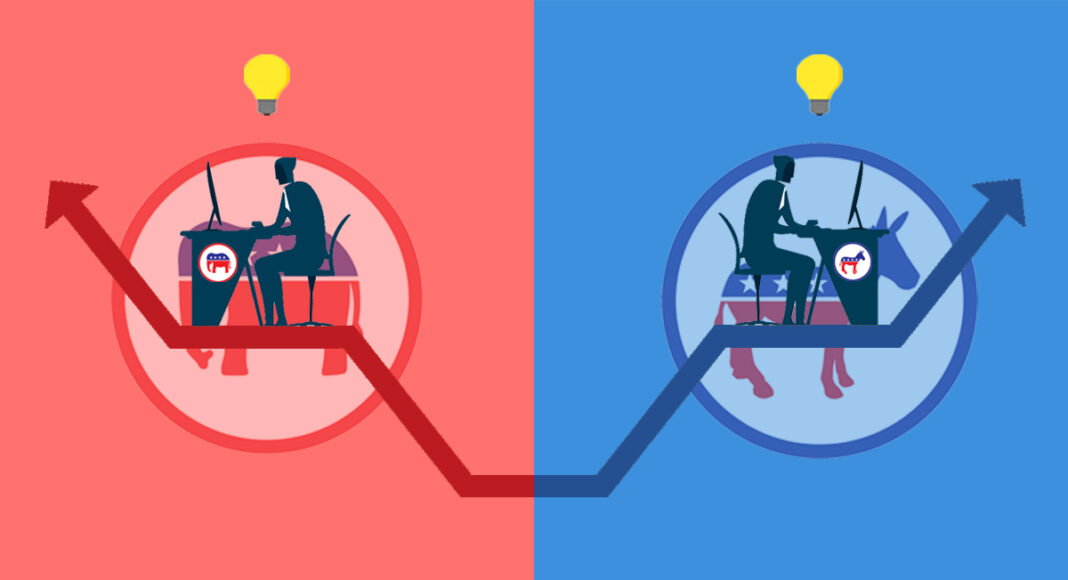Does an inventor’s political identity influence their productivity? In a new paper, Joseph Engelberg, Runjing Lu, William Mullins, and Richard Townsend examine the impacts of the 2008 and 2016 United States presidential elections on Democrat and Republican inventors, with a particular focus on the quantity and quality of patents after the country elects a new president.
United States presidential elections have turned into life-changing events. Voters whose preferred candidate lost the election report sharp decreases in their economic expectations and subjective well-being. For example, Republicans went from being substantially less optimistic about the economy than Democrats immediately before the 2016 election to significantly more optimistic in the first quarter of 2017. This same pattern reversed around the 2020 election. While social scientists often analyze this shift in sentiments through the lens of public opinion polls or stock market fluctuations, a less explored but equally consequential dimension is how this political sea change affects the American workforce.
In a recent study, we document how these political tides influence worker productivity, focusing on a critical group—innovative workers who produce patents. Technological progress is the engine of America’s long-term economic growth. Accordingly, the importance of these inventors’ productivity and their contributions to the economy is not merely a matter of individual career trajectories. We can measure changes in inventors’ productivity by how many patents they submit to the U.S. Patent and Trademark Office. Our hypothesis is that changes in economic optimism could affect patenters’ productivity because those who anticipate a commercial boom due to their preferred candidate winning an election will work harder in order to capture the high economic returns created by a strong economy.
Our study focuses on two pivotal elections: the 2008 election that brought Barack Obama to power and the 2016 election that ushered in the Donald Trump era. Using a database of 380,000 patenters merged with voter registration records, we assess the productivity of Democratic and Republican inventors. The data show that inventors who identify with the winning party applied for more patents after an election relative to those aligned with the losing party. This divergence is not fleeting; the gap in patenting activity between the “winning” and “losing” inventors becomes increasingly pronounced two years after the election and persists for up to six years.
Figure 1: Residualized Probability of Submitting a Patent Application Democrat vs. Republican Inventors
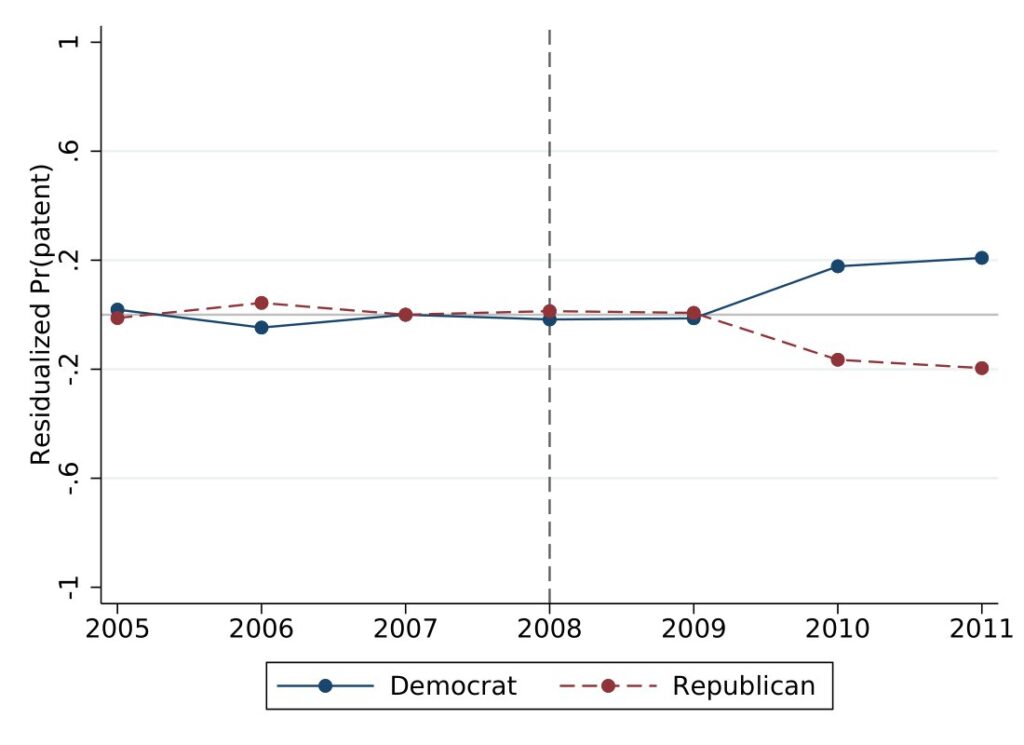
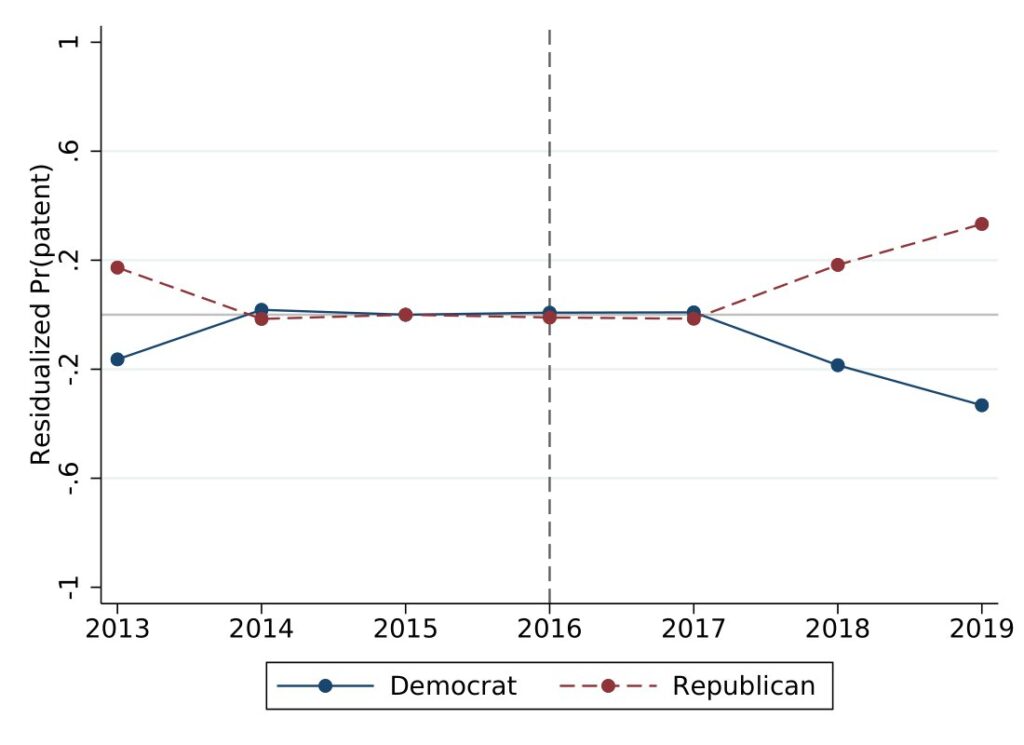
Figure 1 above plots the annual probability of submitting a patent application by political allegiance after removing yearly averages for patent applications by category of technology. Prior to both elections, the trajectories for the two parties are virtually indistinguishable. Post-election, however, we observe a marked divergence. When we use a difference-in-differences event study approach to quantify the effect following the 2008 election, we find that Democratic inventors’ annual likelihood of patenting is 2% of the mean higher than that of Republicans by 2011. In contrast, by the third year after the 2016 election, once they are on the losing side, Democrats’ productivity drops by 3.8% of the mean relative to Republicans.
Political activeness accentuates productivity shifts
To sharpen the evidence that it is the political orientation of inventors that has a causal effect on productivity, we examine politically active inventors. Specifically, we use the voting and donation history of each inventor to identify an active partisan from a less-committed one. The intuition is straightforward: a regime-shift should have greater effects on individuals who are more invested in political elections. If this hypothesis is true, we should see stronger effects among politically active patenters.
This relationship is precisely what we find. Defining politically active patenters as those with an above-median voting propensity in past elections, we estimate that active Democrats’ annual probability of patenting is 4.3% of the mean higher than that for Republicans by 2011, while the probability for inactive Democrats is only 0.8% higher. The 2016 election displays a mirror image. Politically active Democratic patenters experience a 4.7% decline in relative productivity, while their inactive counterparts see a 3.5% drop. Using data on individuals’ history of political donations as a measure of political engagement yields similarly consistent results.
Tech- and firm-level productivity effects
If certain technologies or firms are heavily skewed towards members of one party, there could be macroeconomic consequences resulting from the individual-level effects that we document. For example, if Republican inventors dominate patenting in fracking technologies and they become less productive following Obama’s election in 2008, we would expect fracking technology to lag in its rate of progress following 2008. Motivated by this conjecture, we examine the extent of political segregation in our setting.
We find evidence of significant political segregation among patenters both across firms and across technological areas. For example, Republicans outnumber Democrats 3-to-1 in weapons patenting, but are outnumbered by Democrats 5-to-1 at Google. Table 1 below shows political segregation for the most partisan technology classes and publicly listed firms, as determined by the partisanship of their patenters. Moreover, teams are critical to knowledge production, and we show the likelihood of mixed-party teams (i.e., teams containing both Democrats and Republicans) submitting patents fell by 14% from 2004 to 2019.
Table 1: Party Concentration of Patenters by Technology and by Firm
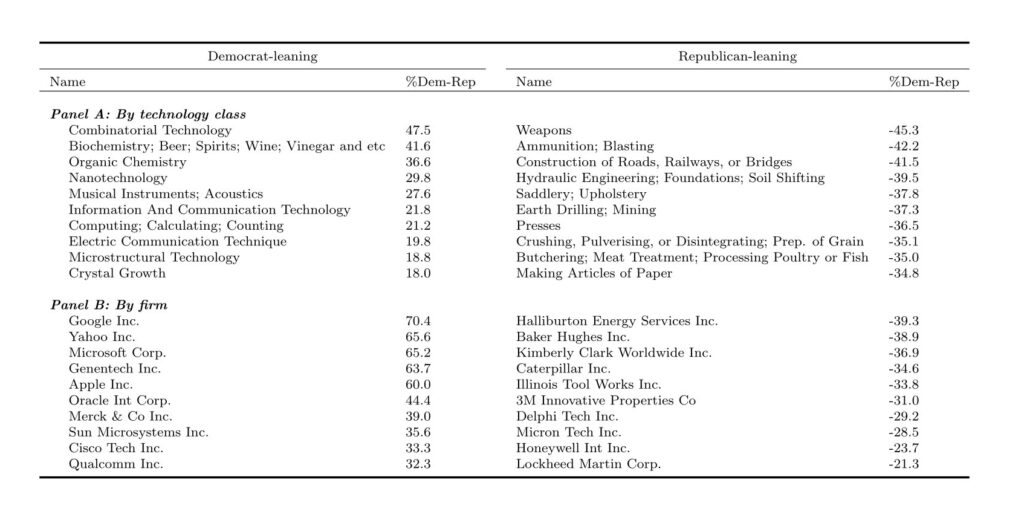
Given the evidence of technology- and firm-level political segregation among patenters, we would expect partisan sentiment shocks to affect sectoral technological progress more broadly. To examine this, we study technology-level patenting patterns around the 2008 election. The data show that technologies dominated by Democrats gain a discernible innovative edge over their Republican-led counterparts post-election. Specifically, Democratic technology subclasses have a standard deviation more granted patents than Republican ones by 2010, a gap that widens to 1.5 standard deviations by 2015, as shown in Figure 2 below.
Figure 2: Political Mismatch and Number of Granted Patents by Technology Subclass
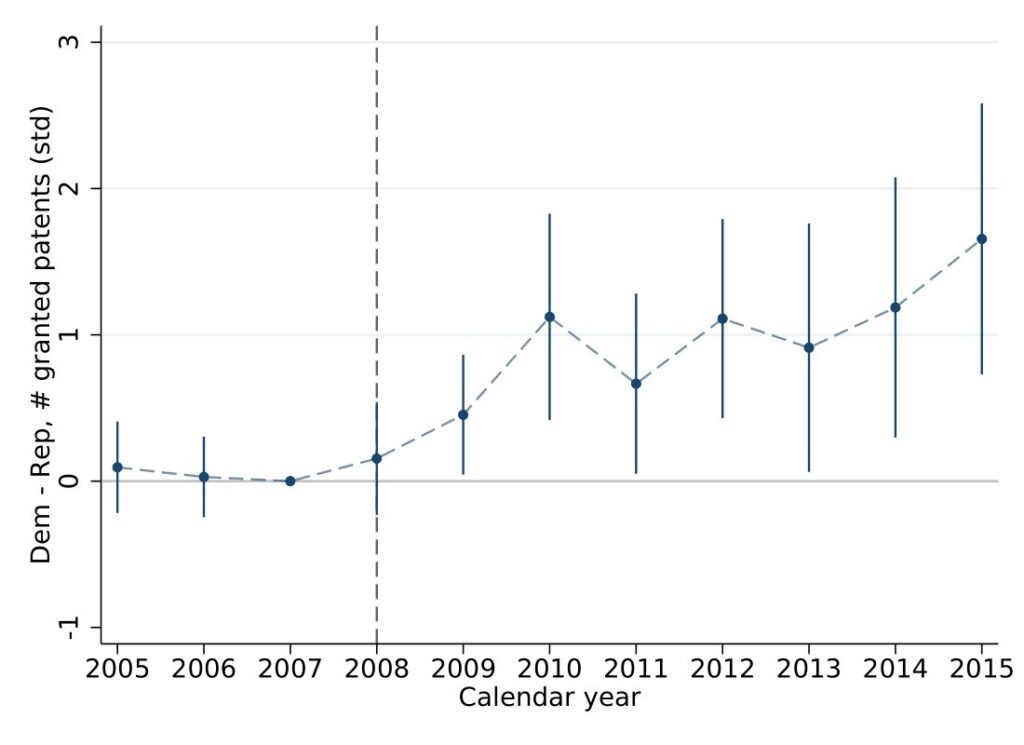
A natural concern is that the individual-level effects we document could be driven by public policy changes at the geographic or industry level. For instance, Trump’s election could have tilted policies in favor of Republican-heavy sectors like oil and gas, while disfavoring Democrat-dominated sectors like renewable energy. One can imagine similar policy changes targeting political geographies. To address this concern, we examine effects within narrow geographic areas and within types of technology. Our conclusions are unchanged. We even compare Republicans and Democrats patenting at the same firm in the same technology and continue to find differences in their productivity. In short, we find no evidence that public policies targeting specific industries or geographies can explain our results.
As Americans become increasingly partisan, there is growing concern that workplaces may become politically homogeneous. We find a pattern of increasing political homogeneity among patenting teams, which in turn may affect the rate of progress across technologies. If current polarization trends continue, we would expect to see even stronger economy-wide productivity effects following future elections or other shocks to political sentiment.
Articles represent the opinions of their writers, not necessarily those of the University of Chicago, the Booth School of Business, or its faculty.





